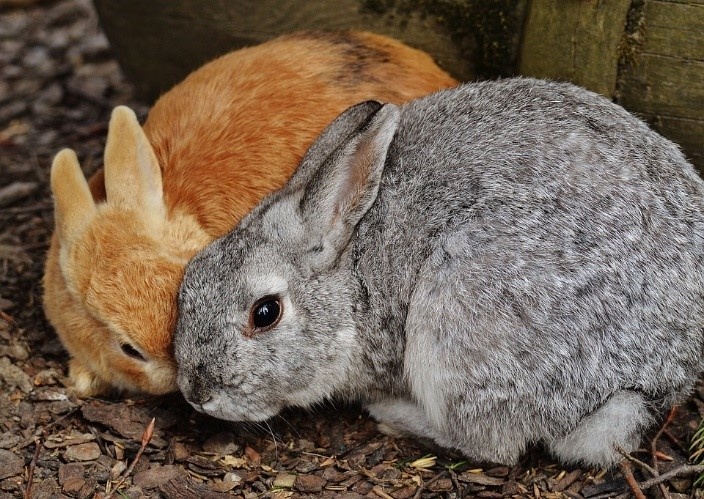- All products are added to your cart.
Hygiene measures to prevent RHD / VHS and myxomatosis in rabbits
Hygiene measures for the prevention of infection with RHD/VHD or Myxomatosis virus in rabbits
Wild rabbits in the Netherlands are currently facing significant challenges. Whereas in the past, Myxomatosis and the classical VHS1 virus were major contributors to a high mortality rate among rabbits, a new variant has emerged in recent years, posing an increasing risk to rabbit health. This virus (VHS2) led to a nationwide rabbit mortality in 2015. To date, these viruses continue to be a significant threat to both wild and domesticated rabbits. Preventing infection in your rabbit is crucial to protect its health and prevent further spread.

Viral Hemorrhagic Syndrome
The Viral Hemorrhagic Syndrome (VHS), also known as VHD (Viral Haemorrhagic Disease) and RHD (Rabbit Haemorrhagic Disease), is a rabbit disease caused by a calicivirus. It is an extremely contagious disease with a rapid and severe progression. After infection with the virus, it spreads quickly throughout the body, and the rabbit becomes ill within 24 to 48 hours of infection.
The VHS virus has two variants, the classical VHS1 virus and a mutation called VHS type 2. The two variants have similar symptoms. An infected rabbit may exhibit (acute) respiratory distress and fever. Internal and external bleeding can also occur. In the case of VHS2, rabbits that survive the acute phase may develop a more chronic illness characterized by weight loss, overall malaise, and jaundice.
However, this is often not the case, and the rabbit may die without showing prior symptoms. Additionally, a more chronic illness may be observed with VHS2, where the rabbit can be generally unwell for an extended period. Unlike VHS1, where the mortality rate is around 80%, the mortality rate for VHS2 is often lower (5-70%). The progression of VHS2 is slower than that of VHS1. Rabbits may sometimes only die 3 to 5 days after infection instead of 1 to 2 days, as seen with VHS1. There is no cure for the VHS virus.
Myxomatosis
Myxomatosis is a severe, often deadly disease in rabbits caused by a virus related to the poxviruses. A rabbit affected by myxomatosis develops swellings around the eyes, mouth, and anus. Bumps then appear on the ears, around the mouth, and on the back—referred to as myxomas. Subsequently, the rabbit develops pneumonia and will ultimately almost always succumb to the disease. In the form transmitted through direct contact, there are hardly any skin swellings; however, red, swollen eyes and respiratory problems often arise. Similar to the VHS virus, there is no treatment for myxomatosis.
Spread The mode of spread for both the VHS virus, the VHS2 virus, and Myxomatosis is almost identical. These viruses spread through direct and indirect contact between rabbits. In cases of indirect contact, think of contact with urine, feces, saliva, water, clothing, and hands that have come into contact with infected animals. Food can also be a source of infection. Does the rabbit eat freshly picked plants? If so, be cautious and ensure that you pick them in areas inaccessible to wild rabbits. Additionally, insects such as mosquitoes and fleas can transmit the virus from one rabbit to another.
Measures
Because the survival chances of a rabbit with the VHS or Myxomatosis virus are very low, preventing infection with these viruses is crucial. By taking the following three measures, the likelihood of infection is minimized:
- Vaccination
Vaccination is the primary measure to take in preventing VHS 1+2/Myxomatosis. Vaccination provides good protection and lasts for one year. Since 2012, there is a new vaccine that protects against both VHS type 1 and myxomatosis with a single vaccination. There is also a vaccine for VHS type 2. For more information about vaccinating your rabbit, contact your veterinarian.
- Avoiding contact with VHS/Myxomatosis risk areas
Prevent contact with wild rabbits. Ensure that wild rabbits cannot enter the enclosure. Infection can also occur through indirect contact, such as feeding freshly picked grass where potentially infected wild rabbits have been. Additionally, it is crucial to avoid letting the rabbit come into contact with footwear that has walked over a potentially contaminated area.
- Hygiene
Thoroughly clean the environment where your rabbit lives. Rinse all surfaces/materials thoroughly with water. It is also important to add a cleaning agent. Clearzym® is an enzymatic cleaning agent that cuts organic dirt such as fats and proteins into minuscule particles, making it easy to rinse away. It has the additional advantage of being highly effective in cold water, unlike other enzymatic cleaning agents.
In addition to proper cleaning, disinfection is crucial. Disinfecting your rabbit's hutch with Virkon™S provides additional protection against both the VHS and Myxomatosis viruses. Virkon™S distinguishes itself from other disinfectants by being highly effective against viruses. At a 1% concentration, Virkon™S has proven effective against the Caliciviridae virus strain, which includes both VHS type 1 and VHS type 2. Virkon™S is also effective against Poxviridae, to which Myxomatosis belongs.
Keeping potential sources of infection out, along with vaccination, proper cleaning, and disinfection significantly reduces the risk of infection with the VHS or Myxomatosis virus. For more information about the function and application of Clearzym and Virkon™S, please contact us.


